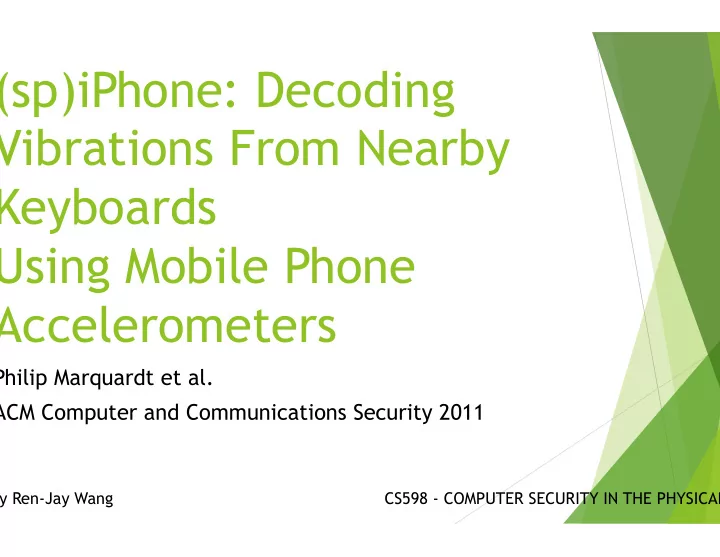

(sp)iPhone: Decoding Vibrations From Nearby Keyboards Using Mobile Phone Accelerometers Philip Marquardt et al. ACM Computer and Communications Security 2011 By Ren-Jay Wang CS598 - COMPUTER SECURITY IN THE PHYSICAL
An old kind of attack
How do we fix this problem? Easy solution: users provide explicit permission
A new kind of attack We can use mobile phone accelerometers to detect vibrations
Related electrical/mechanical emanation attacks Van Eck Phreaking (CRT electromagnetic emanations) Tempest in a teapot: Compromising Reflections Revisited Recreating key presses through a microphone
The new attack Many users place their phones nearby when working on a computer We can use this fact to our advantage to eavesdrop
The result of trying old techniques We choose to use an iPhone 4 because it has a better accelerometer & gyroscope …doesn’t work
So what do we do next? We choose to recognize key pairs instead of individual keys We recognize whether keys are on the LEFT or RIGHT relative to a central line and if they are NEAR or FAR relative to some defined threshold distance α For example, “Canoe” -> LLN LRF RLF RRF Strings of length n can be split into n-1 abstract string representations
Creating our own neural network model Step 1: Learning phase Record each key press 150 times (total 3900 key-press events) Create feature vector for each key drawing from x,y,z accelerations => <mean, kurtosis, variance, min, max, energy, rms, mfccs, ftts> Word labeling: for each n-1 character pairs, concatenate random feature vectors for the corresponding keys Can’t be too specific -> to avoid overtraining, use even distribution of left, right, near and far labels
Creating our own neural network model Step 2: Attack phase Data Collection: Raw-acceleration data is collected Feature Extraction: Feature-vectors are calculated Key-press Classification: L/R labels and N/F labels are classified based on the neural networks Word Matching: Words are matched against a dictionary and sorted; top scores are candidate predictions
How well does our model perform? L/R classifier correctly identifies 91% of the time N/F classifier correctly identifies 65% of the time These percentages drop with more keypresses, which is to be expected
Experimental Results – Tests 1 and 2 Removed words of <= 3 characters Test 1: 1 sentence -> 80% accuracy using first choice Test 2: 10 sentences -> 46% using first choice, 73% within first two choices <- Test 1 Test 2 ->
Experimental Results – Test 3 Comparison to previous work by Berger et al., using dictionary of 57,500 words and sentence with 4-9 characters per word Berger: 43% accuracy within top 10 word guesses Experimental result: 43% as well! Experimental results less accurate than Berger when increasing the number of guesses…limitations?
Experimental Results – Test 4 A more realistic attack – USAToday article Dictionary constructed using seven related news articles 40% in first choice, 53% in top 2, and 80% accuracy in top 5 predictions
Challenges and Limitations Distance and environmental factors – only sure to work within one foot Orientation of the phone Ambient vibration Typing speed Desk surface
How do we fix this vulnerability Short term solutions Don’t get too close! • Permissions on accelerometer • Long term solutions Restricting data resolution to applications • Being careful with all kinds of sensors in the future! •
Discussion Points Key contributions of the paper? Limitations to this attack? Is this paper relevant to other areas of security? Thoughts on improving the accuracy/effectiveness of the attack? What are ways we can combat these kinds of attacks?
Recommend
More recommend